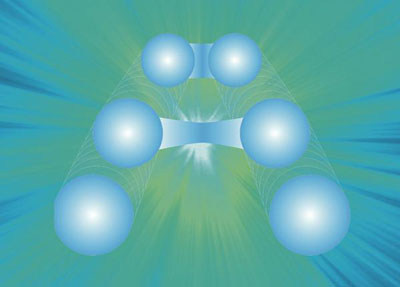| Nov 14, 2012 |
X-ray laser observes molecular explosion
|
|
(Nanowerk News) Using DESY´s X-ray laser FLASH, a team of scientists from Hamburg has traced the ultrafast explosion of iodine molecules. The group headed by Markus Drescher from the Center for Free-Electron Laser Science (CFEL) used the X-ray laser as a kind of high-speed camera -the observed molecular explosion took place within a millionth of a billionth of a second (i.e. within femtoseconds). The scientists presented their measurements in the scientific journal Physical Review A ("Strong-field ionization of molecular iodine traced with XUV pulses from a free-electron laser").
|
|
"Thanks to the ultra-short X-ray pulses of FLASH we are able to trace the time sequence in detail without disturbing the process,"said first author Maria Krikunova, who currently works at Technische Universität Berlin.
|
|
To start the explosion, the team around Drescher and Krikunova shot an infrared laser beam into a gas consisting of diatomic iodine molecules (I2). At 120 femtoseconds, this infrared flash was relatively long compared to the X-ray flashes from the free-electron laser FLASH which last only 35 femtoseconds. "With the X-ray pulse, we are able to look into the much longer infrared pulse,"Krikunova explains. "However, this requires the exact synchronisation of the pulses, which is only possible with a special experimental setup by Theo Maltezopoulos from the University of Hamburg and CFEL."
|
 |
| With its ultra-short pulses, DESY's X-ray laser FLASH can record different phases of the molecular explosion and the rearrangement of electrons between the two atoms.
|
|
It turned out that the infrared pulse strips two outer (valence) electrons from the molecule within the central 75 femtoseconds around the pulse maximum. The chemical bond is disrupted and the now ionised molecule explodes. With FLASH, the scientists were able to record in real time how the remaining valence electrons that were not localised are distributed anew between both iodine atoms.
|
|
The repulsion of the two atoms which are now electrically charged finally causes the explosion of the molecule. This explosion also produces asymmetric states of charge in which an iodine molecule is separated into a neutral and a twice electrically charged iodine atom. After a total of about 120 femtoseconds, the molecules break up. Since the X-ray flashes are absorbed from a completely different part of the atom than the infrared pulses, FLASH is able to observe the system without disturbing the process.
|
|
"We can immediately see how charges reallocate dynamically when molecules are exposed to a strong light field,"said Drescher, who is professor at the University of Hamburg. "With the short-wave flashes of FLASH, we have a probe for the local electrons density at our disposal. This means that we know whether there is more electrical charge in one or the other atom at a certain time."
|
|
These observation possibilities are also the working basis of the successful Hamburg Center for Ultrafast Imaging (CUI), a new federal excellence initiative, with the university and DESY as partners. CFEL too is a cooperation of the University of Hamburg and DESY, with the participation of the Max Planck Society.
|
|
DESY´s FLASH (Free-electron LASer in Hamburg) was the first free-electron laser worldwide for soft X-ray radiation. Free-electron lasers generate laser-like light flashes by sending fast electrons from a powerful particle accelerator through a tight slalom course. In each curve, the electrons emit radiation which amplifies to a laser-like flash. The short wavelengths of only a millionth of a millimeter (nanometres) allow scientists to observe details on a molecular level. With the short flashes with a duration of no more than some billionths of a second (femtoseconds), it is possible to take pictures of ultra-fast processes.
|
|
The European XFEL, currently under construction in the Hamburg area with DESY as its main shareholder, will be the world´s best X-ray laser. DESY is the leading accelerator centre in Germany and one of the leading ones worldwide.
|

